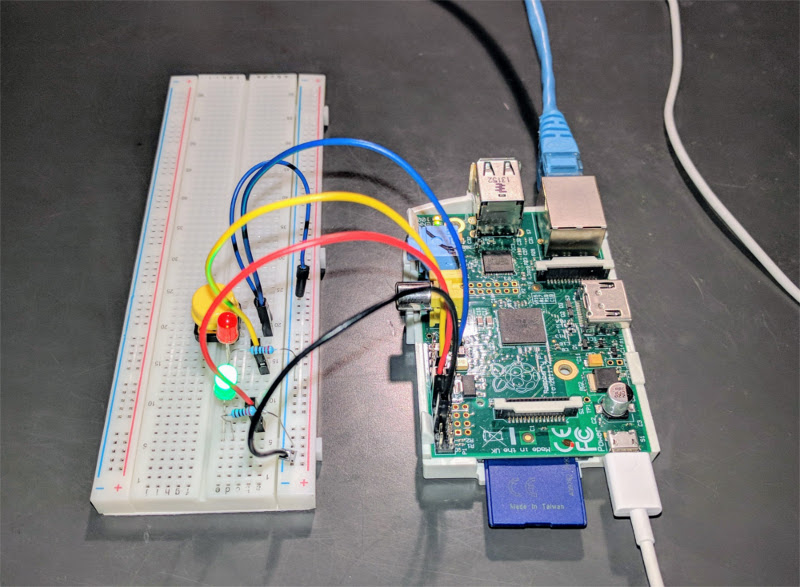A few years ago I bought a Raspberry Pi but I never found time to experiment with the GPIO bus.
Recently I have bought a breadboard and some parts to experiment. I found a nice tutorial and this is the result.

The source code has been written in Python.
The red LED is used to test the digital output functionality.
The green LED is used to test the analog (Pulse Width Modulation) output functionality.
The yellow switch has been used to test the digtal input functionality.
# External module imports
import RPi.GPIO as GPIO
import time
# PIN definitions
# Digital
ledRed = 23 # Broadcom pin 23 (P1 pin 16)
button = 17 # Broadcom pin 17 (P1 pin 11)
# Analog (Pulse Width Modulation)
pwmGreen = 18 # Broadcom pin 18 (P1 pin 12)
dc = 95 # Duty cycle (0-100) for PWM pin
# Pin Setup:
GPIO.setmode(GPIO.BCM) # Broadcom pin-numbering scheme
GPIO.setup(ledRed, GPIO.OUT) # Set as output
GPIO.setup(pwmGreen, GPIO.OUT) # Set as output
pwm = GPIO.PWM(pwmGreen,100) # Initialize PWM on pwmGreen with 100Hz frequency
GPIO.setup(button, GPIO.IN, pull_up_down=GPIO.PUD_UP) # Button pin set as input w/ pull-up
# Initial state for LEDs:
GPIO.output(ledRed, GPIO.LOW)
pwm.start(dc)
print("Here we go! Press CTRL+C to exit")
try:
while True:
if GPIO.input(button): # button is released
pwm.ChangeDutyCycle(dc) # Green led
GPIO.output(ledRed, GPIO.LOW) # Red led
else: # button is pressed:
pwm.ChangeDutyCycle(100-dc) # Green led
GPIO.output(ledRed, GPIO.HIGH) # Red led
time.sleep(0.075)
GPIO.output(ledRed, GPIO.LOW) # Red led
time.sleep(0.075)
except KeyboardInterrupt: # If CTRL+C is pressed, exit cleanly:
pwm.stop() # stop PWM
GPIO.cleanup() # cleanup all GPIO
More details can be found on the website of learn.sparkfun.com.
Links:
https://learn.sparkfun.com/tutorials/raspberry-gpio
https://www.raspberrypi.org/
https://projects.raspberrypi.org/en/projects/physical-computing